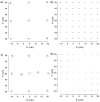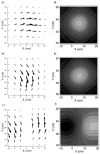Generalization to local remappings of the visuomotor coordinate transformation
- PMID: 8824344
- PMCID: PMC6579263
- DOI: 10.1523/JNEUROSCI.16-21-07085.1996
Generalization to local remappings of the visuomotor coordinate transformation
Abstract
During visually guided movement, visual representations of target location must be transformed into coordinates appropriate for movement. To investigate the representation and plasticity of the visuomotor coordinate transformation, we examined the changes in pointing behavior after local visuomotor remappings. The visual feedback of finger position was limited to one or two locations in the workspace, at which a discrepancy was introduced between the actual and visually perceived finger position. These remappings induced changes in pointing, which were largest near the locus of remapping and decreased away from it. This pattern of spatial generalization highly constrains models of the computation of the visuomotor transformation in the CNS. A simple model, in which the transformation is computed via the population activity of a set of units with large sensory receptive fields, is shown to capture the observed pattern.
Figures








References
-
- Andersen RA. Inferior parietal lobule function in spatial perception and visuomotor integration. In: Plum F, Mountcastle V, editors. Handbook of physiology: the nervous system. Higher functions of the brain. American Physiological Society; Rockville, MD: 1987. pp. 483–518.
-
- Andersen RA, Essick C, Siegel R. Encoding of spatial location by posterior parietal neurons. Science. 1985;230:456–458. - PubMed
-
- Atkeson CG. Learning arm kinematics and dynamics. Annu Rev Neurosci. 1989;12:157–183. - PubMed
-
- Bedford F. Constraints on learning new mappings between perceptual dimensions. J Exp Psychol Hum Percept Perform. 1989;15:232–248.
-
- Bedford F. Perceptual and cognitive spatial learning. J Exp Psychol Hum Percept Perform. 1993a;19:517–530. - PubMed
Publication types
MeSH terms
Grants and funding
LinkOut - more resources
Full Text Sources
